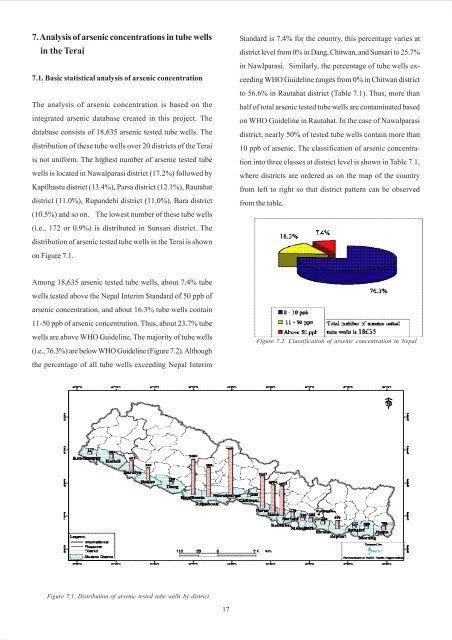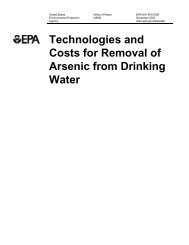The State of Arsenic in Nepal - 2003 - Harvard University ...
The State of Arsenic in Nepal - 2003 - Harvard University ...
The State of Arsenic in Nepal - 2003 - Harvard University ...
You also want an ePaper? Increase the reach of your titles
YUMPU automatically turns print PDFs into web optimized ePapers that Google loves.
7. Analysis <strong>of</strong> arsenic concentrations <strong>in</strong> tube wells<br />
<strong>in</strong> the Terai<br />
7.1. Basic statistical analysis <strong>of</strong> arsenic concentration<br />
<strong>The</strong> analysis <strong>of</strong> arsenic concentration is based on the<br />
<strong>in</strong>tegrated arsenic database created <strong>in</strong> this project. <strong>The</strong><br />
database consists <strong>of</strong> 18,635 arsenic tested tube wells. <strong>The</strong><br />
distribution <strong>of</strong> these tube wells over 20 districts <strong>of</strong> the Terai<br />
is not uniform. <strong>The</strong> highest number <strong>of</strong> arsenic tested tube<br />
wells is located <strong>in</strong> Nawalparasi district (17.2%) followed by<br />
Kapilbastu district (13.4%), Parsa district (12.1%), Rautahat<br />
district (11.0%), Rupandehi district (11.0%), Bara district<br />
(10.5%) and so on. <strong>The</strong> lowest number <strong>of</strong> these tube wells<br />
(i.e., 172 or 0.9%) is distributed <strong>in</strong> Sunsari district. <strong>The</strong><br />
distribution <strong>of</strong> arsenic tested tube wells <strong>in</strong> the Terai is shown<br />
on Figure 7.1.<br />
Standard is 7.4% for the country, this percentage varies at<br />
district level from 0% <strong>in</strong> Dang, Chitwan, and Sunsari to 25.7%<br />
<strong>in</strong> Nawlparasi. Similarly, the percentage <strong>of</strong> tube wells exceed<strong>in</strong>g<br />
WHO Guidel<strong>in</strong>e ranges from 0% <strong>in</strong> Chitwan district<br />
to 56.6% <strong>in</strong> Rautahat district (Table 7.1). Thus, more than<br />
half <strong>of</strong> total arsenic tested tube wells are contam<strong>in</strong>ated based<br />
on WHO Guidel<strong>in</strong>e <strong>in</strong> Rautahat. In the case <strong>of</strong> Nawalparasi<br />
district, nearly 50% <strong>of</strong> tested tube wells conta<strong>in</strong> more than<br />
10 ppb <strong>of</strong> arsenic. <strong>The</strong> classification <strong>of</strong> arsenic concentration<br />
<strong>in</strong>to three classes at district level is shown <strong>in</strong> Table 7.1,<br />
where districts are ordered as on the map <strong>of</strong> the country<br />
from left to right so that district pattern can be observed<br />
from the table.<br />
Among 18,635 arsenic tested tube wells, about 7.4% tube<br />
wells tested above the <strong>Nepal</strong> Interim Standard <strong>of</strong> 50 ppb <strong>of</strong><br />
arsenic concentration, and about 16.3% tube wells conta<strong>in</strong><br />
11-50 ppb <strong>of</strong> arsenic concentration. Thus, about 23.7% tube<br />
wells are above WHO Guidel<strong>in</strong>e. <strong>The</strong> majority <strong>of</strong> tube wells<br />
(i.e., 76.3%) are below WHO Guidel<strong>in</strong>e (Figure 7.2). Although<br />
the percentage <strong>of</strong> all tube wells exceed<strong>in</strong>g <strong>Nepal</strong> Interim<br />
Figure 7.2. Classification <strong>of</strong> arsenic concentration <strong>in</strong> <strong>Nepal</strong><br />
Figure 7.1. Distribution <strong>of</strong> arsenic tested tube wells by district<br />
17

















